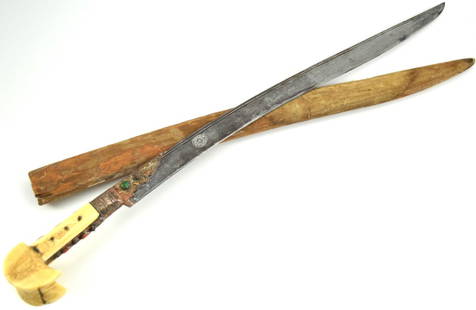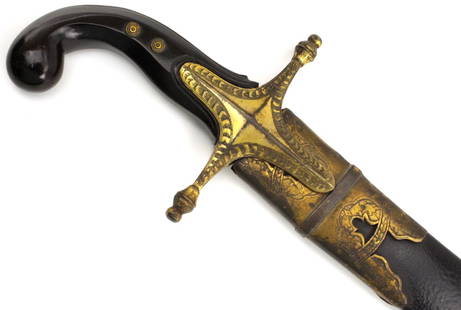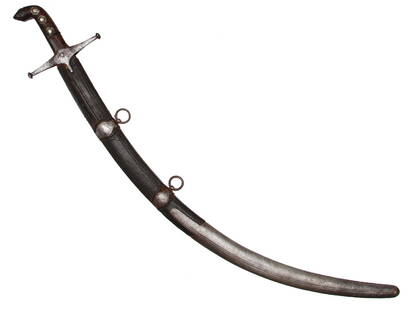
Very Good 18th-19th C. Turkish SHAMSHIR Sword ~ Black Wootz Damascus Blade ~ Ottoman Empire,
Similar Sale History
View More Items in Weapons & Armor



Related Weapons & Armor
More Items in Turkish Weapons & Armor
View MoreRecommended Collectibles
View More





















Item Details
Description
A fine representation of one of the distinct swords of the Ottoman Empire, this sword is most classically called a shamshir and is distinguished by the deeply curved blade, the finest of which are mounted with wootz blades, such as this example. The shamshir in its classic form such as this example was developed in the 16th centuries and was primarily associated most closely with Persian swords of the period. The Ottomans, though devout enemies of the Persians, adopted Persian blades through trade and capture, many of which were mounted in Ottoman style hilts. Shamshir means "lions tail" and describes the deeply curved and continuously tapering parabolic saber blade typical of the Islamic world from Persia through to Mughal India from the middle of the 16th century. Contemporary illustrations most often show these swords being worn within scabbards, suspended horizontally and diagonally with the edge down, at the wearer's left side. Though the deeply curved blades are adapted for the draw cut at the expense of thrusting, these swords are known to have been carried by dismounted warriors as well as mounted warriors where the slashing technique was the preferred form of fencing for Islamic warriors. The blade of this shamshir has an especially fine wootz pattern of dark Kara Khorasan style wootz with no damages or flaws. These mirror like wootz blades were considered especially fine as the watering of the blade brought to mind poetry for the Muslim warrior and the embellishment of gold would have been considered as against Islamic teaching, though that has not prevented many other blades from being embellished with gold throughout the ages. These seemingly simple blades would have been highly valued for the quality of the watered steel. Total Length (inside scabbard if present) : 38 1/4", Blade Length : 33 1/4".~~. References: 1. Elgood, R. (2009). The Arms of Greece. Thames and Hudson.2. Hales, R. (2013). A Lifetime Passion: Islamic and Oriental Arms and Armor, 3. Pinchot, O. (2002) On the Persian Shamshir and the Signature of Assad Allah. Journal of Arms Collecting. 4. Egerton, Lord of Tatton, (1896). A Description of Indian and Oriental Armour. London, W. H. Allen & Co5. Ferrel, J. (1998), The Dr. Leo S. Figiel Collection of Mogul Arms. (San Francisco: Butterfield & Butterfield. 6. Figel, L.S., (1991) On Damascus Steel. Atlantis, Florida: Atlantis Arts Press. ~~. Detailed condition reports are not included in this catalog. For additional information, including condition reports, please contact us at info@sofedesignauctions.com
Buyer's Premium
- 25%
Very Good 18th-19th C. Turkish SHAMSHIR Sword ~ Black Wootz Damascus Blade ~ Ottoman Empire,
Estimate $2,000 - $3,000
23 bidders are watching this item.
Shipping & Pickup Options
Item located in Richardson, TX, usSee Policy for Shipping
Local Pickup Available
Payment
Accepts seamless payments through LiveAuctioneers

TOP
































































![George Washington Signed Discharge: Partly printed discharge document signed by George Washington, as Commander in Chief of the Armies of the United States. Newburgh, [New York], 4 January 1783. 1 page, ## x ## in. Undersigned by Washin](https://p1.liveauctioneers.com/7226/322253/173251475_1_x.jpg?height=310&quality=70&version=1710004847)

